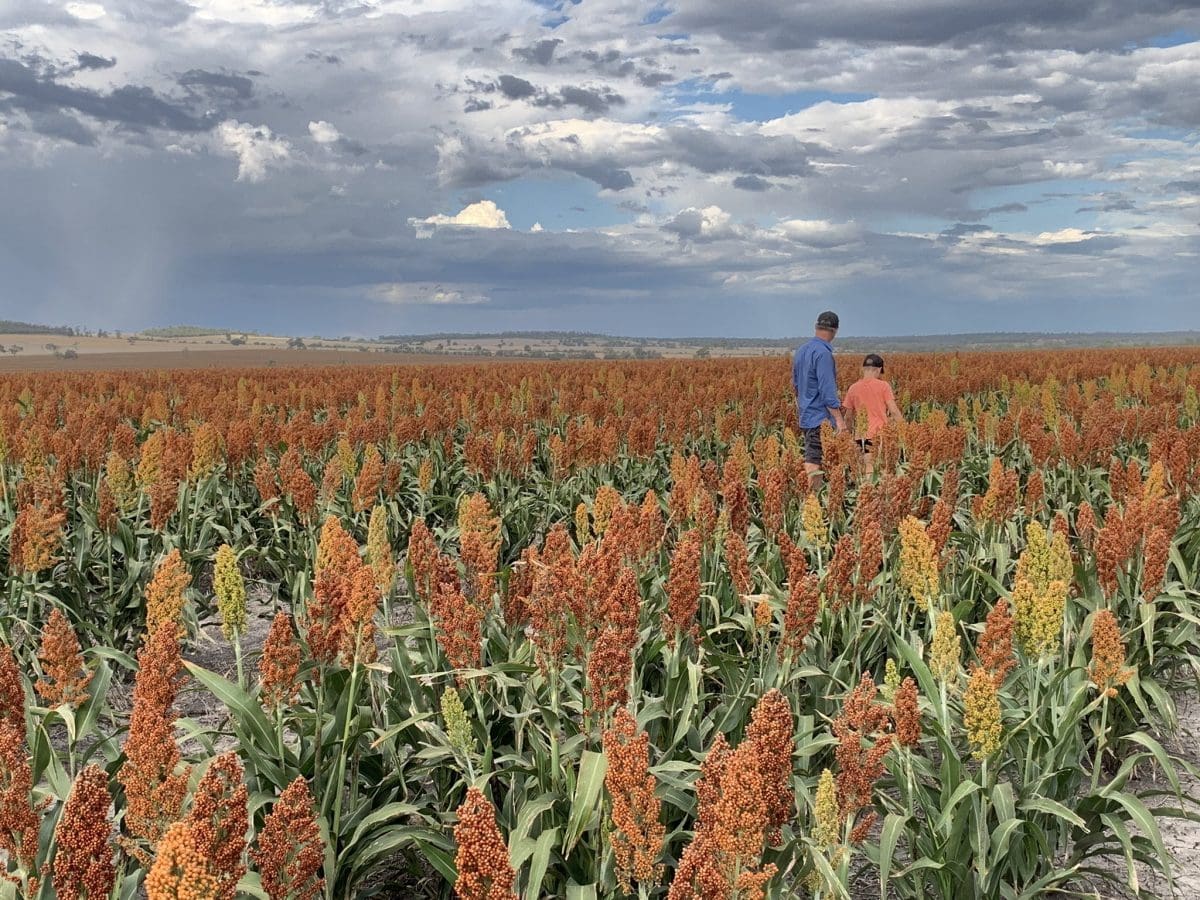
Lee and son Hamish Coleman inspect a sorghum crop nearing maturity at Croppa Creek in northern NSW. Photo: CroppaCo
SUBDUED demand from a contracting feedlot market in the north and a concentration on export execution rather than accumulation in the south have seen markets for wheat and barley trade steady to slightly lower in the past week.
Sources have said a wholesale switch to wheat from barley in feedlot rations could be on the cards, based on wheat being more readily available in large volume in the north now that export slots and domestic flour-milling demand are fast filling.
Sorghum appears to be pricing into the north Asian market, and early crops in northern New South Wales are making their way to container packers.
Sorghum’s premium to wheat is keeping it out of cattle feed rations, and most poultry rations too.
In its latest monthly supply-and-demand estimate released today, Lachstock Consulting has increased its forecast for new-crop Australian sorghum by 150,000 tonnes to 1.3 million tonnes, with the increase due more to late plantings than improved yields.
The Lachstock estimate has pencilled in 370,000t for NSW, 240,000t for Central Queensland and 740,000t for southern Queensland, with China and Japan seen as the major export markets.
| This week | Last week | Change | |
| Barley Downs Mar | $278 | $280 | Down |
| Barley Melbourne Mar | $265 | $265 | Flat |
| Wheat Downs Mar | $312 | $315 | Down |
| Wheat Melbourne Mar | $315 | $315 | Flat |
| Sorghum Downs Mar-Apr | $325 | $325 | Flat |
Table 1: Indicative prices in AUD per tonne.
Cattle shortage felt
Feeder cattle remain in extremely short supply in NSW and southern Queensland as graziers with ample paddock feed opt to grow out their animals to slaughter weights.
“Ideas about the number of cattle we’ve got on feed in Queensland keep dropping,” one source said.
“That means the coverage we’ve already got will do us for longer than we thought.”
Most up-country consumers in Queensland and northern NSW appear to be fully covered into early May.
On the Downs, they are paying premium prices — up to $15/t above this week’s quoted levels — for barley stored on-farm around the NSW-Qld border.
“That’s about as close as we can find it now,” one Downs trader said.
Traders are said to be looking at the price of barley, which is now at around 90 per cent of the value of wheat and could well price itself out of some feed demand, now that the spread between the white grains has narrowed.
Export slots fill
Feed mills are believed to have consumed or booked just about all the barley produced in Queensland this year, while NSW barley is feeding onshore and offshore markets.
Both bulk terminals in Newcastle are booked solid with wheat and durum shipments but no barley.
What is thought to be the first panamax of NSW barley to load since 2017 is due to berth in Port Kembla later this month, where a handy-sized barley vessel is also on the stem.
These slots underpin ideas that the NSW market is trading at export parity.
In Victoria and southern NSW, growers are selling a load or two of barley for a minimum of $200/t or so as awareness grows about the approaching inverse export values face once the Northern Hemisphere crop hits the world market in July.
“You can’t get a shipping slot until June or July,” one southern trader said.
“There’s every incentive to make export sales; there’s an $18/t difference between where the delivered Melbourne market is for barley at $265 and the price in the latest Saudi tender.
“The key is getting another cargo into the stem.”
Domestic consumers are hopeful the realisation of the inverse Australian growers face mid year will prompt some grower selling, as traders appear largely to have priced their parcels of wheat and barley into the export market.
“Barley seems to be around $200/t to the grower for consumers in the domestic market, but some growers are looking for $240/t,” Temora-based trader Bill Preston said.
“What’s putting a floor in the market are the bids for warehoused grain.”
From the south-west slopes of NSW and into Victoria, more barley than wheat appears to be held on farm.
“Most of the wheat was sold at harvest.”
Containers add support
Wilken Grain trader Andrew Kelso said container business is generating some demand now that bulk export slots have neared capacity.
“There’s still some container activity, and there’s underlying interest there for pulses, canola and grain,” Mr Kelso said.
“That will keep a floor in the market.
“There’s enough grain to keep the market supplied, and the trade is in the process of executing what it’s booked.”
